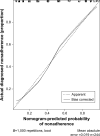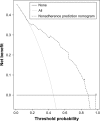Predicting medication nonadherence risk in a Chinese inflammatory rheumatic disease population: development and assessment of a new predictive nomogram
- PMID: 30237698
- PMCID: PMC6136915
- DOI: 10.2147/PPA.S159293
Predicting medication nonadherence risk in a Chinese inflammatory rheumatic disease population: development and assessment of a new predictive nomogram
Abstract
Purpose: The aim of this study was to develop and internally validate a medication nonadherence risk nomogram in a Chinese population of patients with inflammatory rheumatic diseases.
Patients and methods: We developed a prediction model based on a training dataset of 244 IRD patients, and data were collected from March 2016 to May 2016. Adherence was evaluated using 19-item Compliance Questionnaire Rheumatology. The least absolute shrinkage and selection operator regression model was used to optimize feature selection for the medication nonadherence risk model. Multivariable logistic regression analysis was applied to build a predicting model incorporating the feature selected in the least absolute shrinkage and selection operator regression model. Discrimination, calibration, and clinical usefulness of the predicting model were assessed using the C-index, calibration plot, and decision curve analysis. Internal validation was assessed using the bootstrapping validation.
Results: Predictors contained in the prediction nomogram included use of glucocorticoid (GC), use of nonsteroidal anti-inflammatory drugs, number of medicine-related questions, education level, and the distance to hospital. The model displayed good discrimination with a C-index of 0.857 (95% confidence interval: 0.807-0.907) and good calibration. High C-index value of 0.847 could still be reached in the interval validation. Decision curve analysis showed that the nonadherence nomogram was clinically useful when intervention was decided at the nonadherence possibility threshold of 14%.
Conclusion: This novel nonadherence nomogram incorporating the use of GC, the use of nonsteroidal anti-inflammatory drugs, the number of medicine-related questions, education level, and distance to hospital could be conveniently used to facilitate the individual medication nonadherence risk prediction in IRD patients.
Keywords: Compliance Questionnaire Rheumatology; inflammatory rheumatic diseases; noadherence; nomogram; predictors.
Conflict of interest statement
Disclosure The authors report no conflicts of interest in this work.
Figures




Similar articles
-
Predicting population: development and validation of a new predictive nomogram for evaluating medication nonadherence risk in a type 2 diabetes.PeerJ. 2022 Mar 15;10:e13102. doi: 10.7717/peerj.13102. eCollection 2022. PeerJ. 2022. PMID: 35310157 Free PMC article.
-
Predicting treatment failure risk in a Chinese Drug-Resistant Tuberculosis with surgical therapy: Development and assessment of a new predictive nomogram.Int J Infect Dis. 2020 Jul;96:88-93. doi: 10.1016/j.ijid.2020.03.035. Epub 2020 Mar 20. Int J Infect Dis. 2020. PMID: 32205286
-
Development of a Novel Nomogram for Predicting Premature Rupture of Membrane in Pregnant Women With Vulvovaginal Candidiasis.Front Med (Lausanne). 2021 Nov 15;8:717978. doi: 10.3389/fmed.2021.717978. eCollection 2021. Front Med (Lausanne). 2021. PMID: 34869416 Free PMC article.
-
Development and Internal Validation of a Nomogram to Predict Post-Stroke Fatigue After Discharge.J Stroke Cerebrovasc Dis. 2021 Feb;30(2):105484. doi: 10.1016/j.jstrokecerebrovasdis.2020.105484. Epub 2020 Nov 27. J Stroke Cerebrovasc Dis. 2021. PMID: 33253982
-
Predicting prolonged postoperative length of stay risk in patients undergoing lumbar fusion surgery: Development and assessment of a novel predictive nomogram.Front Surg. 2022 Aug 16;9:925354. doi: 10.3389/fsurg.2022.925354. eCollection 2022. Front Surg. 2022. PMID: 36051703 Free PMC article.
Cited by
-
Development and validation of a predictive risk model based on retinal geometry for an early assessment of diabetic retinopathy.Front Endocrinol (Lausanne). 2022 Nov 21;13:1033611. doi: 10.3389/fendo.2022.1033611. eCollection 2022. Front Endocrinol (Lausanne). 2022. PMID: 36479215 Free PMC article. Clinical Trial.
-
Exploring the diagnostic value of eosinophil-to-lymphocyte ratio to differentiate Kawasaki disease from other febrile diseases based on clinical prediction model.Sci Rep. 2023 Feb 28;13(1):3399. doi: 10.1038/s41598-023-30463-9. Sci Rep. 2023. PMID: 36854770 Free PMC article.
-
Development and Validation of a Nomogram and a Comprehensive Prognostic Analysis of an LncRNA-Associated Competitive Endogenous RNA Network Based on Immune-Related Genes for Locally Advanced Rectal Cancer With Neoadjuvant Therapy.Front Oncol. 2021 Jul 19;11:697948. doi: 10.3389/fonc.2021.697948. eCollection 2021. Front Oncol. 2021. PMID: 34350117 Free PMC article.
-
Development of a machine learning model to predict the risk of late cardiogenic shock in patients with ST-segment elevation myocardial infarction.Ann Transl Med. 2021 Jul;9(14):1162. doi: 10.21037/atm-21-2905. Ann Transl Med. 2021. PMID: 34430603 Free PMC article.
-
Prediction of Late Hospital Arrival in Patients with Mild and Rapidly Improving Acute Ischemic Stroke in a Rural Area of China.Risk Manag Healthc Policy. 2023 Jun 20;16:1119-1129. doi: 10.2147/RMHP.S414700. eCollection 2023. Risk Manag Healthc Policy. 2023. PMID: 37360537 Free PMC article.
References
-
- Osterberg L, Blaschke T. Adherence to medication. N Engl J Med. 2005;353(5):487–497. - PubMed
-
- Burkhart PV, Sabate E. Adherence to long-term therapies: evidence for action. J Nurs Scholarsh. 2003;35(3):207. - PubMed
-
- Costedoat-Chalumeau N, Tamirou F, Piette JC. Treatment adherence in systemic lupus erythematosus and rheumatoid arthritis: time to focus on this important issue: treatment adherence in SLE and RA. Rheumatology (Oxford, England) 2017 Sep;:11. Epub. - PubMed
LinkOut - more resources
Full Text Sources
Other Literature Sources
Miscellaneous

